When adopting or rescuing a cat, many people face a common question: is it a boy or a girl? Especially with kittens, determining the sex can be tricky. But with the right knowledge, identifying a cat’s gender becomes much easier. This guide walks you through key methods to distinguish between male and female cats accurately.

1. Physical Anatomy: The Gold Standard
Anogenital Distance
The most reliable method to determine a cat’s sex is by observing the distance between the anus and the genital opening:
Male cats: The distance is longer, about 2.5 to 4 cm. The arrangement resembles a colon “:”.
Female cats: The distance is shorter, only about 1 to 1.5 cm. The layout looks like an upside-down exclamation mark “!”.
Genital Structure
Male cats: The genital opening is round. By around 10 weeks of age, the scrotum becomes visible, often appearing as two small bulges.
Female cats: The vulva appears as a vertical slit with no protruding structures, forming a smooth surface.
This method is widely recognized as the “gold standard” for identifying a cat’s gender, especially after three weeks of age.

2. Appearance and Behavioral Clues
While not definitive on their own, appearance and behavior can serve as useful supplementary indicators.
Size and Facial Features
Male cats: Tend to be larger, with broader heads and fuller cheeks.
Female cats: Generally smaller, with more delicate and refined facial features.
Coat Color Associations
Calico/Tortoiseshell cats: Almost always female, as expressing three coat colors requires two X chromosomes. Male calicos are extremely rare (approx. 1 in 3,000).
Orange tabbies: The gene for orange fur is carried on the X chromosome. Since males have only one X, about 75% of orange cats are male.
Behavioral Traits
Male cats: Often more energetic, curious, and territorial.
Female cats: Tend to be more cautious, affectionate, and clingy toward their owners.
3. Special Techniques for Identifying Kittens
Determining the gender of very young kittens requires extra attention:
2 weeks and older: The genital opening begins to show its shape—round (dot-like) for males and slit-like for females.
Cryptorchidism in males: In some males, the testicles do not descend. In such cases, gentle palpation or an ultrasound may be needed for confirmation.

4. Genetic Clues to a Cat’s Sex
Coat color and gender are linked on a genetic level:
Male calicos: Require two X chromosomes and one Y chromosome (XXY), which is a genetic anomaly. These cats are rare and usually sterile.
Orange fur inheritance: The orange gene resides on the X chromosome. Female cats need two X chromosomes carrying the orange gene to display the color, while males only need one.
5. Gender Symbols in Cultural Beliefs
Beyond biology, cats also carry symbolic meanings in some cultures:
Japanese Maneki-neko (Lucky Cat):
Right paw raised: Represents a male cat and is believed to attract wealth.
Left paw raised: Represents a female cat and is thought to attract love and companionship.
Although not scientific, such symbols reflect long-standing human observations and interpretations of feline traits.
Conclusion
Determining a cat’s sex doesn’t have to be a mystery. By examining the physical anatomy first, and then considering secondary traits like size, coat color, and behavior—along with genetic knowledge—you can make an accurate determination. Mastering these simple tips can help you better care for your feline friend or make an informed choice when adopting.






